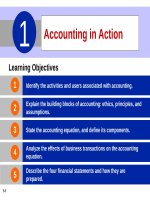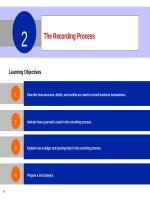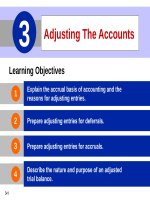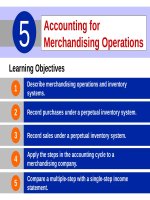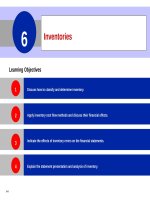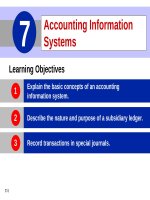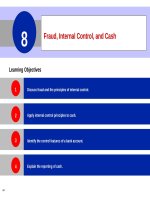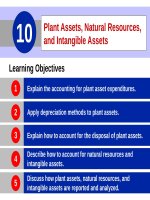Accounting principles 12th willey kieso chapter 02
Bạn đang xem bản rút gọn của tài liệu. Xem và tải ngay bản đầy đủ của tài liệu tại đây (3.21 MB, 56 trang )
2
The Recording Process
Learning Objectives
2-1
1
Describe how accounts, debits, and credits are used to record business transactions.
2
Indicate how a journal is used in the recording process.
3
Explain how a ledger and posting help in the recording process.
4
Prepare a trial balance.
LEARNING
1
OBJECTIVE
Describe how accounts, debits, and credits are used to record business
transactions.
The
Account
Record of increases and decreases in a specific asset, liability,
owners’ equity, revenue, or expense item.
Debit = “Left”
Credit = “Right”
An account can be illustrated in
a T-account form.
2-2
LO 1
The Account
DEBIT AND CREDIT PROCEDURES
Double-entry system
Each transaction must affect two or more accounts to keep the basic accounting equation in
balance.
2-3
Recording done by debiting at least one account and crediting at least one other account.
DEBITS must equal CREDITS.
LO 1
Debits and Credits
If the sum of Debit entries are greater than the sum of Credit entries, the account will have a
debit balance.
Account Name
Debit / Dr.
Transaction #1
$10,000
Transaction #3
8,000
Balance
2-4
Credit / Cr.
$3,000
Transaction #2
$15,000
LO 1
Debits and Credits
If the sum of Credit entries are greater than the sum of Debit entries, the account will have a
credit balance.
Account Name
Debit / Dr.
Transaction #1
Balance
2-5
$10,000
Credit / Cr.
$3,000
Transaction #2
8,000
Transaction #3
$1,000
LO 1
Debits and Credits
2-6
Assets - Debits should exceed credits.
Liabilities – Credits should exceed debits.
Normal balance is on the increase side.
LO 1
Debits and Credits
Owner’s investments and revenues increase owner’s equity
(credit).
Owner’s drawings and expenses decrease owner’s equity
(debit).
Helpful Hint Because
revenues increase owner’s
equity, a revenue account
has the same debit/credit
rules as the Owner’s
Capital account. Expenses
have the opposite effect.
2-7
LO 1
Debits and Credits
The purpose of earning revenues is to benefit the owner(s).
The effect of debits and credits on revenue accounts is the
same as their effect on Owner’s Capital.
Expenses have the opposite effect: expenses decrease
owner’s equity.
2-8
LO 1
Debits/Credits Rules
2-9
Normal
NormalBalance
Balance
Normal
NormalBalance
Balance
Debit
Debit
Credit
Credit
LO 1
Debits/Credits Rules
Balance Sheet
Asset
=
Liability
Income Statement
+ Equity
Revenue
- Expense
Debit
Credit
2-10
LO 1
Debits/Credits Rules
Question
Debits:
2-11
a.
increase both assets and liabilities.
b.
decrease both assets and liabilities.
c.
increase assets and decrease liabilities.
d.
decrease assets and increase liabilities.
LO 1
Debits/Credits Rules
Question
Accounts that normally have debit balances are:
2-12
a.
assets, expenses, and revenues.
b.
assets, expenses, and equity.
c.
assets, liabilities, and owner’s drawing.
d.
assets, owner’s drawing, and expenses.
LO 1
Summary of Debit/Credit Rules
Relationship among the assets, liabilities and owner’s equity of a business:
Illustration 2-11
Basic Equation
Assets = Liabilities +
Owner’s Equity
Expanded Equation
Debit/Credit Effects
The equation must be in balance after every transaction. Total Debits must equal total Credits.
2-13
LO 1
DO IT!
1
Normal Account Balances
Kate Browne has just rented space in a shopping mall. In this space, she will open a hair salon to be called “Hair It Is.” A
friend has advised Kate to set up a double-entry set of accounting records in which to record all of her business
transactions. Identify the balance sheet accounts that Kate will likely need to record the transactions needed to open her
business. Indicate whether the normal balance of each account is a debit or a credit.
Assets
Liabilities
Equity
Cash (debit)
Notes payable (credit)
Owner’s Capital (credit)
Supplies (debit)
Accounts payable (credit)
Equipment (debit)
2-14
LO 1
LEARNING
OBJECTIVE
2
Indicate how a journal is used in the
recording process.
Steps in the Recording Process
Illustration 2-12
Analyze each transaction
Enter transaction in a journal
Transfer journal information to ledger accounts
Business documents, such as a sales slip, a check, or a bill, provide evidence of the transaction.
2-15
LO 2
Steps in the Recording Process
The Journal
Book of original entry.
Transactions recorded in chronological order.
Contributions to the recording process:
1.
Discloses the complete effects of a transaction.
2.
Provides a chronological record of transactions.
3.
Helps to prevent or locate errors because the debit and credit amounts can be easily
compared.
2-16
LO 2
Steps in the Recording Process
JOURNALIZING - Entering transaction data in the journal.
Illustration: On September 1, Ray Neal invested $15,000 cash in the business, and Softbyte purchased computer
equipment for $7,000 cash.
Illustration 2-13
GENERAL JOURNAL
Sept. 1
Cash
15,000
Owner’s Capital
Equipment
Cash
2-17
15,000
7,000
7,000
LO 2
Steps in the Recording Process
SIMPLE AND COMPOUND ENTRIES
Illustration: On July 1, Butler Company purchases a delivery truck costing $14,000. It pays $8,000 cash now and
agrees to pay the remaining $6,000 on account.
Illustration 2-14
Compound journal entry
GENERAL JOURNAL
July 1
2-18
Equipment
14,000
Cash
8,000
Accounts payable
6,000
LO 2
2-19
LO 2
DO IT!
2
Recording Business Activities
Kate Browne engaged in the following activities in establishing her salon, Hair It Is:
1.
Opened a bank account in the name of Hair It Is and deposited $20,000 of her own money in this
account as her initial investment.
2.
Purchased equipment on account (to be paid in 30 days) for a total cost of $4,800.
3.
Interviewed three persons for the position of hair stylist.
Prepare the entries to record the transactions.
2-20
LO 2
DO IT!
2
Recording Business Activities
Prepare the entries to record the transactions.
1.
Opened a bank account and deposited $20,000.
Cash 20,000
Owner’s Capital
2.
Purchased equipment on account (to be paid in 30 days) for a total cost of $4,800.
Equipment
3.
20,000
4,800
Accounts Payable
4,800
Interviewed three persons for the position of hair stylist.
No entry
2-21
LO 2
LEARNING
3
OBJECTIVE
Explain how a ledger and posting help in the recording process.
The Ledger
General Ledger contains all the asset, liability, and owner’s equity accounts.
Illustration 2-15
2-22
LO 3
2-23
LO 3
The Ledger
STANDARD FORM OF ACCOUNT
2-24
Illustration 2-16
Three-column form of account
LO 3
Ledger
POSTING
Transferring journal
entries to the ledger
accounts.
Illustration 2-17
Posting a journal entry
2-25
LO 3

